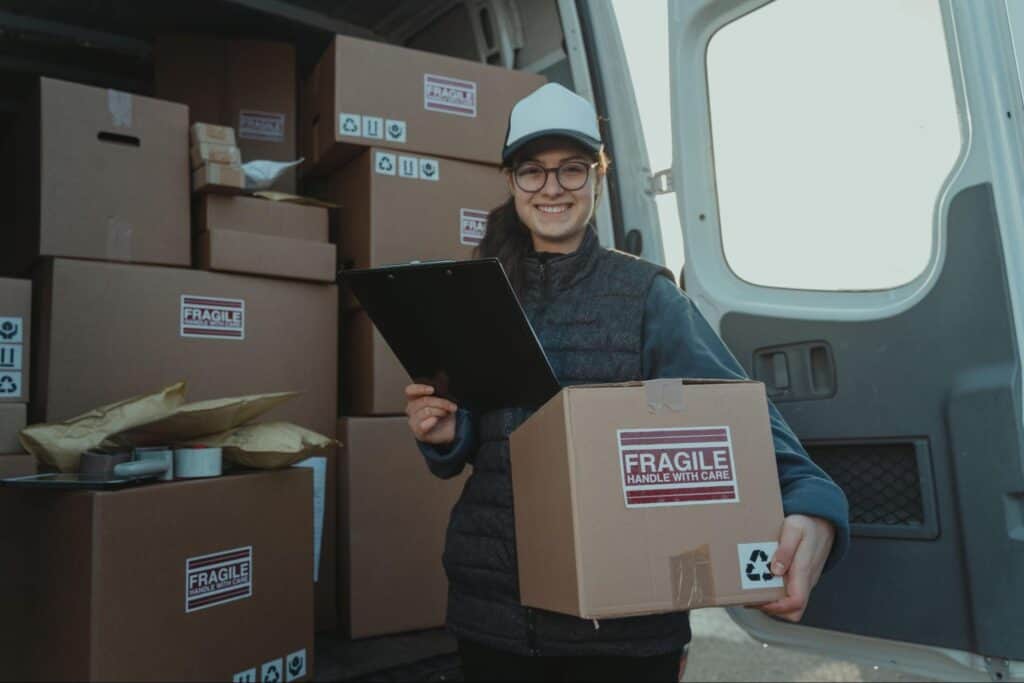
What is Final Mile Delivery? How It Works, Best Practices & More

Wise Systems
What is Final Mile Delivery? How It Works, Best Practices & More

Wise Systems

Final mile delivery is a critical part of the broader supply chain and logistics industry. Referring to the final journey of a product to the customer’s doorstep. It’s a time-consuming and costly process, yet it has a significant impact on customer satisfaction. In this article, we’ll explore what final mile delivery is, challenges of final mile delivery, and how to optimize your final mile delivery process.
In this article:
- What is Final Mile Delivery?
- Supply Chain Milestones
- Challenges of Final Mile Delivery
- Solutions and Innovations in Final Mile Delivery
- Optimizing Final Mile Delivery
- Frequently Asked Questions
What is Final Mile Delivery?
Final mile delivery, also known as last mile delivery, is the last step in the delivery process when a package is transported from a distribution hub to its ultimate destination, typically a business or personal residence.
It has gained significant attention in recent years due to the rise of eCommerce, which is expected to surpass $6.5 trillion this year. Companies like Amazon have created a culture of immediacy, with customers expecting ultra-fast and efficient delivery services.
To meet these expectations, businesses are focusing on customer-centric eCommerce operations and strategies. This includes omnichannel supply chains and inventory forecasting to predict demand and ensure products are available for fast delivery.
Supply Chain Milestones

The supply chain is a complex network of activities that moves goods from a point of origin to the point of consumption. This transportation part of this process can be broken down into three major milestones:
1. The First Mile
The first mile is the first stage in a product’s journey to the customer. It involves the movement of goods from the manufacturer to the next stage, which could be a:
- Warehouse
- Distribution center
- Transport hub
During this process, goods are packaged, labeled, and shipping documents are prepared. The execution of this step sets the tone for the rest of the journey. Errors or inefficiency can have a ripple effect on the subsequent stages.
2. The Middle Mile
The middle mile involves the long-distance transportation of products and goods. This may involve various modes of transportation, including trucks, ships, airplanes, and/or trains. Goods might pass through customs, be stored at a port or hub, and be loaded and unloaded multiple times.
It’s during this stage that goods are brought to their final facility before being scheduled for delivery and loaded onto transportation for final local delivery. This stage is crucial for maintaining the integrity of products and ensuring they arrive at their final location on time. Most product loss and damage occur during this long-range travel.
3. The Final Mile
As previously mentioned, the final mile is the last step of the transportation process. This stage is often the most convoluted and costly part of the entire shipping process. Despite its name, this journey can involve a few blocks or several miles. There are several subprocesses that occur during this stage:
- Sorting – Once goods have reached the local distribution center or warehouse, they are sorted based on their final destination. This could be by area, postal code, or specific delivery routes.
- Route Optimization – Delivery routes are created and optimized using advanced software to ensure the most efficient path is taken. It takes into account various factors, such as navigation through urban areas with heavy traffic and limited parking or rural areas where delivery points might be far apart.
- Loading – With a delivery route plan for guidance, packages are loaded onto delivery vehicles. Depending on the vehicle type, loading is often done in a specific order to match the delivery route and minimize the time spent at each stop.
- Delivery – The delivery vehicle sets off on its route. At each stop, the delivery person unloads the package(s), checks the delivery address, and delivers the package to the customer..
- Proof of Delivery – Upon delivery, the customer may need to sign for the package as proof of delivery. Some delivery services also take a photo of the delivered package at the customer’s doorstep as proof and/or barcode scan it, as well.
- Real-Time Tracking – Throughout the delivery process, real-time tracking updates are often provided to both the customer and the delivery company. This allows the customer to know when to expect their package and the company to monitor the process of deliveries.
The final mile is also the most important from a customer satisfaction standpoint. It’s the last touchpoint between the business and the customer, and any delays or issues can significantly impact the customer’s overall experience.
Challenges of Final Mile Delivery
The final mile delivery process is fraught with challenges. It is often the most expensive and time-consuming part of the shipping process, accounting for up to 53% of the total costs of shipments.
Factors contributing to the complexity of last mile delivery include:
- Short-delivery timeframes
- Elevated delivery expectations
- Cost of fuel
- Last-minute route changes
- Failed deliveries
- Packages stolen after delivery
Different geographic areas present different challenges. Urban areas can be particularly troublesome due to narrow roads, heavy traffic, and limited parking for delivery vehicles. Conversely, rural locations often require drivers to travel long distances between stops, dramatically increasing travel times and fuel costs.
Delivering large and heavy items, such as furniture, or time-sensitive items, such as perishables, adds more complexity and often requires additional resources.
Solutions and Innovations in Final Mile Delivery
In response to these industry-wide obstacles, companies are investing in technology and infrastructure to improve the final mile delivery process.
For instance, the use of GPS technology and telematics in delivery vehicles provides valuable insights into the movement and diagnostics of said vehicles, in addition to automating compliance (where applicable). This enables route optimizations for quicker deliveries and ensures that vehicles are kept up to date on maintenance to maximize uptime.
Other innovative solutions, such as autonomous vehicles, drones, and robots, are also being explored. For example, Nuro, a robotics company, has debuted an autonomous, zero-occupancy delivery vehicle that can carry up to 500 pounds. Amazon has also announced a pilot program for its delivery drone services called Amazon Prime Air.
These and other innovations not only improve efficiency but also productivity, as staff can focus on higher-value tasks like exception management and customer service rather than repetitive tasks.
Optimizing Final Mile Delivery

By optimizing the final mile delivery process, businesses can significantly improve customer satisfaction while reducing operational costs. Here are some of the best practices for last mile delivery:
- Invest in Technology – Utilize advanced software solutions to automate and optimize route creation, track deliveries in real-time, and manage inventory. This can reduce delivery times and improve efficiency. Cutting-edge AI and machine learning technologies are especially helpful in predicting demand and optimizing delivery routes.
- Customers First – Keep customers informed about the status of their delivery. Provide real-time tracking information and notify customers of any delays or changes in delivery times. Clear and timely communication can enhance the customer experience.
- Flexible Delivery Options – Offer flexible delivery options such as same-day delivery, scheduled delivery times, and pick-up points (lockers or UPS offices). This helps reduce failed deliveries and associated costs of re-delivery.
- Training for Delivery Personnel – Provide comprehensive training for delivery personnel to ensure they are effective with customer contact. They should be equipped to handle customer queries, manage returns, and deal with any issues that arise during delivery.
- Analyze and Improve – Regularly analyze delivery performance using key metrics such as delivery speed, delivery success rate, and customer feedback. Use this data to identify areas for improvement and implement necessary changes.
- Partner with a Reliable Delivery Service – If outsourcing, choose a reliable delivery service provider that aligns with the company’s brand values and meets delivery standards. Consider factors such as their technology capabilities, fleet size, and reputation.
As the final touchpoint between the business and the customer, final mile delivery is a critical piece of the supply chain. That is why many businesses are turning to innovative software solutions to optimize their final mile delivery process.
One such solution is the Wise Systems delivery automation platform, powered by the Dynamic Optimization Engine (DOE) that uses artificial intelligence (AI) to continuously ingest and analyze operational data. This allows for data-backed decisions and provides real-time recommendations to improve the efficiencies of last mile delivery operations.
The Wise Systems platform includes features to maximize resource utilization, track and enhance operational performance, and ultimately deliver a superior customer experience. Request a demo to learn more about how Wise Systems can transform your final mile delivery process.
Frequently Asked Questions
What exactly is final mile delivery?
Final mile delivery, or last mile delivery, signals the end of the delivery process, as a package is transported from the last distribution facility to the customer’s home or business.
How has the rise of eCommerce impacted final mile delivery?
The rise of eCommerce has significantly increased the demand for last mile delivery services. As more consumers shop online, there is a greater need for efficient and reliable delivery services to transport goods to customers’ homes. This has led to a surge in demand for final mile delivery, making it a critical focus area for businesses and logistics providers.
How does final mile delivery differ in urban and rural areas?
Final mile delivery in urban areas often involves navigation through heavy traffic and dealing with limited parking, while in rural areas, it may involve long distances between delivery points.
In urban areas, there may be more opportunities for consolidation of deliveries and the use of alternative delivery methods like bikes or on-foot couriers. Rural deliveries may require more planning and resources due to the distance between stops and potentially difficult terrain. Logistics providers are exploring alternative delivery locations like pick-up points to lessen the burden.
How are failed deliveries handled in final mile delivery?
Failed deliveries are typically handled by rescheduling the delivery. Some delivery services provide customers with options for redelivery, pick up from a local depot, or leaving the packing in a safe place or with a neighbor.
It’s important for delivery services to have clear policies and communication around failed deliveries to mitigate the associated costs or redelivery and to ensure customer satisfaction.
What future trends are expected in last mile delivery?
Future innovations in final mile delivery are expected to be driven by technological advances and changing consumer expectations. They include increased use of AI and machine learning for route optimization and demand forecasting, greater use of autonomous vehicles and drones for delivery, and a stronger focus on sustainability.
As consumers increasingly expect fast and flexible delivery options, services like same-day delivery and time-slot delivery are likely to become more common.

